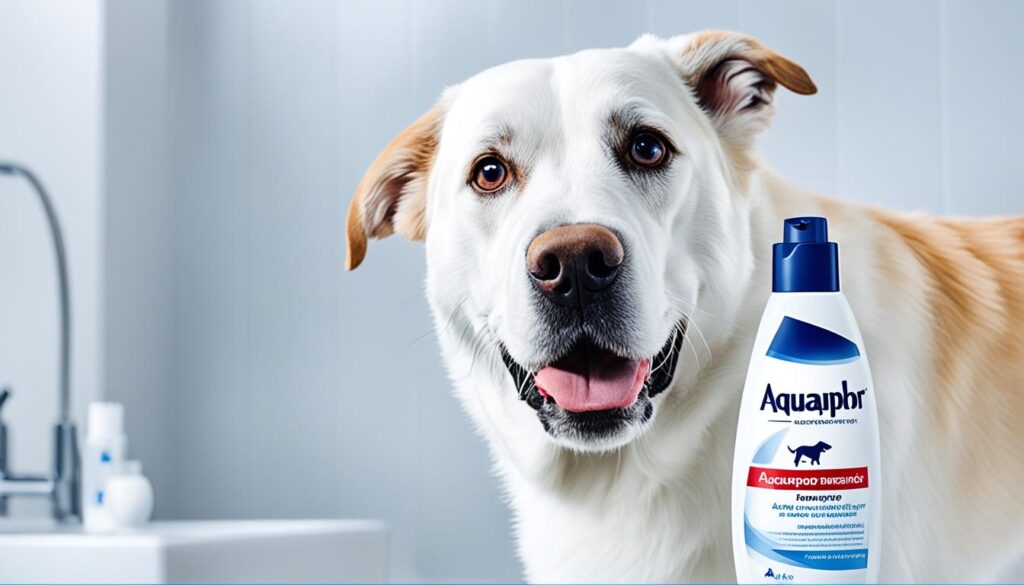Is Aquaphor Safe for Dogs? Veterinarian Advice
If you’re a dog owner, you may have encountered various skin issues that affect your furry friend. From dry and cracked paw pads to crusty noses and dry elbows, these problems can be uncomfortable and irritating for your loyal companion. One popular skincare product that many people wonder about is Aquaphor. But is Aquaphor safe for dogs?
Aquaphor is a moisturizing cream that forms a protective barrier on the skin, promoting healing and hydration. It is commonly used by humans for dry and chapped lips, eczema, and minor cuts. But can you use Aquaphor on dogs as well?
The answer is yes, Aquaphor can be safe to use on dogs for various skin issues. However, it’s essential to consult with a veterinarian before using Aquaphor on your dog. They can provide expert advice and determine if Aquaphor is the most suitable treatment for your dog’s specific needs.
When using Aquaphor on your dog, it’s crucial to follow the correct application method to ensure optimal results. Wash your dog’s face and let it air dry before applying a thin layer of Aquaphor on the affected areas, such as the nose, paw pads, or elbows. Avoid rubbing it in and let it sit for a few minutes before gently wiping away any excess cream.
While Aquaphor offers various benefits for dogs, there are some potential side effects to be aware of. Ingesting large amounts of Aquaphor can lead to gastrointestinal issues like diarrhea and vomiting. Additionally, some dogs may develop allergies or sensitivities to the ingredients in Aquaphor, resulting in skin irritations or other adverse reactions.
Key Takeaways
- Aquaphor can be safe for dogs and is commonly used for treating dry and cracked paw pads, crusty noses, and dry elbows.
- Consult with a veterinarian before using Aquaphor on your dog to ensure its safety and appropriateness for your dog’s specific needs.
- Follow the proper application method by washing your dog’s face, applying a thin layer of Aquaphor, and gently wiping away any excess cream.
- While Aquaphor generally offers benefits, be vigilant for any signs of discomfort or negative reactions in your dog.
- It is not recommended to apply Aquaphor on hot spots in dogs; consult with a veterinarian for the most effective treatment.
How to Apply Aquaphor Correctly on Your Dog
When it comes to using Aquaphor on your dog, proper application is key to ensure its effectiveness. Follow these steps to apply Aquaphor correctly:
- Step 1: Cleanse the affected area
- Step 2: Apply a thin layer
- Step 3: Allow it to sit
- Step 4: Gently wipe away excess
- Step 5: Repeat as directed
Start by washing your dog’s face or the area where you intend to apply Aquaphor. Use a mild, pet-friendly cleanser and gently rinse off any dirt or debris. Pat the area dry or allow it to air dry completely before proceeding.
Once the area is clean and dry, use your fingertips or a clean cotton swab to apply a thin layer of Aquaphor. Focus on the specific area in need of treatment, such as the nose, paw pads, or elbows. Avoid rubbing the product in, as it works best when left as a protective barrier on the skin.
After applying the Aquaphor, allow it to sit on the skin for a few minutes. This gives the product time to absorb and create a protective layer before it may be inadvertently wiped away.
After a few minutes, gently wipe away any excess Aquaphor using a clean, soft cloth or paper towel. Be careful not to rub too vigorously, as this may remove the product completely.
Follow your veterinarian’s instructions regarding how often to apply Aquaphor to your dog’s skin. Depending on the condition being treated, you may need to repeat the application daily or as directed by your vet.
By following these steps, you can ensure that Aquaphor is applied correctly and maximize its benefits for your dog’s skin.
Benefits of Aquaphor for Dogs
Aquaphor offers several benefits for dogs, making it an excellent choice for canine skincare. Whether your dog has minor cuts and scrapes, dry and cracked paw pads, or crusty noses and dry elbows, Aquaphor can help alleviate these issues effectively.
One of the key advantages of Aquaphor is its ability to promote healing and hydration. The moisturizing cream forms a protective barrier on your dog’s skin, preventing further damage and allowing the skin to repair itself. This can be particularly beneficial for dogs with dry and cracked areas.
Aquaphor is suitable for dogs of all breeds, ages, and sizes, including puppies over 12 weeks old. This versatility ensures that no matter your dog’s specific needs, Aquaphor can provide relief and improve their skin condition. Additionally, Aquaphor is non-greasy and odorless, ensuring a comfortable and pleasant application experience for both you and your dog.
Furthermore, Aquaphor is readily available at most drugstores, making it a convenient and cost-effective option for canine skincare. You can easily purchase it without the need for a prescription, allowing you to provide immediate relief for your furry companion.

Testimonial:
“Aquaphor has been a game-changer for my dog’s dry and cracked paw pads. After just a few days of consistent application, I noticed a significant improvement in their condition. It’s a product I highly recommend to any dog owner looking to soothe their furry friend’s irritated skin.” – Jane Thompson, Dog Owner
Benefits of Aquaphor for Dogs:
| Benefit | Description |
|---|---|
| Treats minor cuts and scrapes | Aquaphor helps in healing minor wounds, preventing infection, and promoting faster recovery. |
| Soothes dry and cracked paw pads | Regular application of Aquaphor can moisturize and soften your dog’s paw pads, relieving discomfort and preventing further cracking. |
| Alleviates crusty noses and dry elbows | For dogs with crusty noses or dry elbows, Aquaphor provides hydration and soothing relief, helping to restore and protect their skin. |
Side Effects of Using Aquaphor on Dogs
While Aquaphor is generally safe for dogs, it is important to be aware of the potential side effects that may occur when using it on your furry friend. Understanding these side effects can help you make an informed decision about whether Aquaphor is the right choice for your dog’s skincare needs.
Allergies and Sensitivities
Some dogs may develop allergies or sensitivities to the ingredients in Aquaphor, which can lead to skin irritations or other adverse reactions. Common symptoms of an allergic reaction may include redness, itching, swelling, or a rash on the area where Aquaphor was applied.
If you notice any signs of discomfort or negative reactions on your dog’s skin after using Aquaphor, discontinue use and consult with a veterinarian for further guidance. They can help determine if your dog is experiencing an allergic reaction to the product and recommend alternative treatment options.
Diarrhea from Ingestion
If your dog accidentally ingests a large amount of Aquaphor, it can cause gastrointestinal upset, including diarrhea. While the ingredients in Aquaphor are generally considered non-toxic, ingesting a significant quantity can disrupt your dog’s digestive system and lead to digestive issues.
It is important to keep Aquaphor out of your dog’s reach and ensure they do not have access to the product. If your dog does ingest Aquaphor, monitor their symptoms and contact a veterinarian for further guidance on how to manage any potential digestive discomfort.
Close Monitoring and Consultation
When using Aquaphor on your dog’s skin, it is crucial to closely monitor their reaction, especially during the initial applications. Keep an eye out for any signs of irritation or unusual behavior and consult with a veterinarian if you have any concerns.
Remember, every dog is unique, and what may be safe for one dog may not be suitable for another. It is always best to consult with a veterinarian before using any skincare product, including Aquaphor, on your dog. They can provide personalized advice based on your dog’s specific needs and help ensure their safety and well-being.
| Potential Side Effects of Aquaphor on Dogs | Symptoms | Actions to Take |
|---|---|---|
| Allergic Reaction | Redness, itching, swelling, rash | Discontinue use and consult a veterinarian |
| Diarrhea from Ingestion | Gastrointestinal upset, diarrhea | Monitor symptoms and contact a veterinarian |

As with any skincare product, it is important to weigh the potential benefits against the potential risks. While Aquaphor can be an effective solution for certain skin issues in dogs, it is always recommended to consult with a professional to ensure the safety and well-being of your furry companion.
Can I Put Aquaphor on my Dog’s Hot Spots?
Aquaphor is a versatile skincare product that offers many benefits for dogs. While it can be used for various skin issues, it is important to understand its limitations. When it comes to hot spots, applying Aquaphor is not recommended.
Hot spots, also known as acute moist dermatitis, are moist, red, and inflamed skin lesions that can be quite painful for dogs. They occur as a result of various factors like allergies, insect bites, or self-inflicted itching. When a hot spot develops, it is essential to seek appropriate treatment to promote healing.
Using Aquaphor on hot spots can actually exacerbate the condition. Aquaphor is a moisturizing cream that forms a protective barrier on the skin, which can trap moisture near the hot spot. This moisture accumulation can delay the healing process and make the hot spot worse.
Instead of using Aquaphor, it is recommended to consult with a veterinarian for proper treatment of hot spots. Veterinarians may prescribe topical antibiotic sprays or creams specifically designed to address hot spots in dogs. These medications help eliminate the underlying infection and inflammation, providing relief and aiding the healing process.
“When it comes to hot spots, it is best to consult with a veterinarian for proper treatment. They can prescribe the most effective medications and provide guidance on managing hot spots in dogs.”
In some cases, hot spots may require oral antibiotics, depending on the severity of the infection. Veterinarians will assess the condition and determine the appropriate course of action to ensure the best outcome for your furry friend.
Summary:
| Can I Put Aquaphor on my Dog’s Hot Spots? | |
|---|---|
| Recommended Approach | Avoid using Aquaphor on hot spots |
| Reasoning | Aquaphor can trap moisture and delay healing |
| Alternative Treatment | Consult a veterinarian for prescribed topical antibiotic sprays or creams |
| Severe Cases | Oral antibiotics may be necessary |
Is Aquaphor Safe to Ingest?
While Aquaphor is safe for external use on dogs, it is not intended for ingestion. It is important to prevent your dog from consuming Aquaphor, as it can lead to gastrointestinal upset and discomfort. Although the ingredients in Aquaphor are generally considered non-toxic, ingesting a large amount can cause digestive issues such as diarrhea and vomiting.
If your dog accidentally ingests Aquaphor, it is important to monitor their symptoms closely. Look out for any signs of gastrointestinal distress, such as excessive drooling, discomfort, or changes in appetite. If you notice any concerning symptoms, it is best to contact your veterinarian for further guidance.
Remember that Aquaphor is designed for topical use and is formulated to be safe when applied externally on the skin. It is always recommended to follow the directions provided by your veterinarian and use products specifically designed for internal use when addressing any internal health concerns your pet may have.
| Pros | Cons |
|---|---|
| Aquaphor provides a protective barrier on the skin, promoting healing and hydration | Avoiding ingestion prevents potential gastrointestinal upset and discomfort |
| Ingredients are generally considered non-toxic | Ingesting large amounts can cause diarrhea and vomiting |
| Aquaphor is safe for topical use on dogs’ skin | Best to consult with a veterinarian for any internal health concerns |
Conclusion
Aquaphor can be a safe and effective option for treating various skin issues in dogs, including dryness, cracked paw pads, and crusty noses. This moisturizing cream forms a protective barrier on the skin, promoting healing and hydration. However, it is crucial to use Aquaphor correctly and consult with a veterinarian before applying it to your dog.
When using Aquaphor on your dog, it is important to follow the guidance of a veterinarian. They can provide the appropriate dosage and frequency of application for your dog’s specific needs. Additionally, it is vital to monitor your dog for any adverse reactions or allergies to the product. If your dog experiences any discomfort or negative symptoms, discontinue use and seek veterinary advice.
Before using any skincare product on your dog, it is always recommended to consult with a veterinarian. They can assess your dog’s individual needs and provide expert guidance on the most suitable treatment options. Remember, your dog’s safety and well-being should always be the top priority when considering skincare products.
FAQ
Is Aquaphor safe to use on dogs?
Aquaphor is generally safe to use on dogs for various skin issues such as dry and cracked paw pads, crusty noses, and dry elbows. However, it is important to consult with a veterinarian before using Aquaphor on your dog to ensure its safety and appropriateness for your dog’s specific needs.
How should I apply Aquaphor on my dog?
When applying Aquaphor on your dog, wash your dog’s face and let it air dry. Then, apply a thin layer of Aquaphor on the affected area, such as the nose, paw pads, or elbows. Avoid rubbing it in and let it sit for a few minutes before gently wiping away any excess. Repeat this process daily or as directed by your veterinarian for best results.
What are the benefits of using Aquaphor on dogs?
Aquaphor effectively treats minor cuts and scrapes, soothes dry and cracked paw pads, and helps alleviate crusty noses and dry elbows in dogs. It is suitable for dogs of all breeds, ages, and sizes, including puppies over 12 weeks old. Aquaphor is also non-greasy, odorless, and available at most drugstores, making it a convenient and cost-effective option for canine skin care.
Are there any side effects of using Aquaphor on dogs?
While Aquaphor is generally safe for dogs, there are some potential side effects to be aware of. If large amounts of Aquaphor are ingested, it can cause diarrhea in dogs. Additionally, some dogs may develop allergies or sensitivities to the ingredients in Aquaphor, leading to skin irritations or other adverse reactions. It is important to monitor your dog for any signs of discomfort or negative reactions when using Aquaphor and consult with a veterinarian if necessary.
Can I put Aquaphor on my dog’s hot spots?
It is not recommended to apply Aquaphor on hot spots in dogs. Aquaphor can trap moisture near the skin, exacerbating the hot spots and delaying the healing process. Instead, a veterinarian may prescribe a topical antibiotic spray or cream for treating hot spots. The most effective treatment for hot spots often involves oral antibiotics prescribed by a veterinarian.
Is Aquaphor safe to ingest?
Aquaphor is not intended for ingestion and should not be given to dogs to consume. While the ingredients in Aquaphor are generally considered non-toxic, ingesting a large amount can lead to gastrointestinal upset, including diarrhea and vomiting. If your dog ingests Aquaphor, it is important to monitor their symptoms and contact a veterinarian for further guidance.
Can I use Aquaphor on my dog?
Aquaphor can be a safe and beneficial option for treating certain skin issues in dogs, such as dryness, cracked paw pads, and crusty noses. However, it is important to use Aquaphor correctly, following the guidance of a veterinarian. It is also crucial to monitor your dog for any adverse reactions or allergies to the product. Always consult with a veterinarian before using any skincare product on your dog to ensure their safety and well-being.


